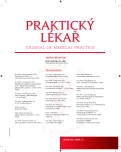Allergy vaccine in general practice
Authors:
L. Bittner; M. Vašáková
Authors‘ workplace:
Přednosta: prof. MUDr. Jiří Homolka, DrSc.
; Primářka: doc. MUDr. Martina Vašáková, Ph. D.
; Pneumologická klinika 1. LF UK a Thomayerovy nemocnice, Praha
Published in:
Prakt. Lék. 2014; 94(3): 126-130
Category:
Of different specialties
Overview
„Allergy vaccines“ or properly said Specific Allergen Immunotherapy is a process when the exactly specified allergens, to which is the patient hypersensitive, are dosed to the patient’s organism. Allergy is a systemic disease with its local manifestation as a rhinoconjuctivitis, sinusitis, malfunction of olfactory sense, nasal polyposis, otitis media, hearing malfunction, asthma bronchiale and GIT malfunction. Some patients suffer from non-specific problems like insomnia, snore, headaches, overall exhaustion, underperformance with concentration malfunction, sometimes even depressive episodes. Timely dispatch of patients with symptoms of allergic inflammation to the allergist and initiation of Specific Allergen Immunotherapy (SIT) is the most important step in prevention of the chronic problems. Only allergist-clinical immunologist has possibility to choose three different forms of SIT: subcutaneous, sublingual in form of drops and sublingual in form of tablets. Indications and contraindications of this therapy should not be generalized, but should be assessed individually. SIT is absolutely indicated especially in the cases of anaphylactic reaction to insect stings. The minimum treatment period is 3–5 years or more and requires absolute cooperation of the patient to be efficient.
Keywords:
rhinoconjuctivitis – Specific Allergen Immunotherapy – cooperation of the patient – anaphylactic reaction
Sources
1. Alvares-Cuesta E, Bousquet J, Canonica GW, et al. Standards for practical allergen-specific immunoterapy. Allergy 2006; 61(Suppl 82): 1–20.
2. Canadian Society of Allergy and Clinical Immunology. Guidelines for the use of allergen immunotherapy. CMAJ 1995;152(9): 1419–1423.
3. Čáp P, Průcha M. Alergologie v kostce. Praha: Triton 2006; 117.
4. Kalabusová B. Specifická alergenová imunoterapie u pacientů s komorbiditami. Alergie 2013; 2: 135.
5. Kolektiv autorů Pomocník alergologa a klinického imunologa. Semily: Geum 2013; 190–195.
6. Rybníček O, Seberová E, Brož P, a kol. Průvodce specifickou alergenovou imunoterapii (SIT). 2. vyd. Praha: Tigis 2009.
7. Rybníček O. Alergická rýma. In Petrů V. a kol. Dětská alergologie. Praha: Mladá fronta 2012; 271.
8. Špičák V, Panzer P. Alergologie. Praha: Galén 2004; 133.
9. Vernerová E. Specifická alergenová imunoterapie a autoimunitní onemocnění. Alergie 2012, 14(1): 73–75.
10. Wedi B, Rueff F. Pharmacoprophylaxis and co-medications in allergen specific immunotherapy. Hautarzt 2011; 62(9): 63–70.
Labels
General practitioner for children and adolescents General practitioner for adultsArticle was published in
General Practitioner

2014 Issue 3
- Memantine Eases Daily Life for Patients and Caregivers
- Metamizole vs. Tramadol in Postoperative Analgesia
- Metamizole at a Glance and in Practice – Effective Non-Opioid Analgesic for All Ages
- Memantine in Dementia Therapy – Current Findings and Possible Future Applications
- What Effect Can Be Expected from Limosilactobacillus reuteri in Mucositis and Peri-Implantitis?
Most read in this issue
- Allergy vaccine in general practice
- Children poisoning – experiences of Poisons Information Centre in Prague
- Facial pain: rhinosinusitis or other reason?
- Results of Adam’s test of scoliotic vertebral rotation in primary school students
